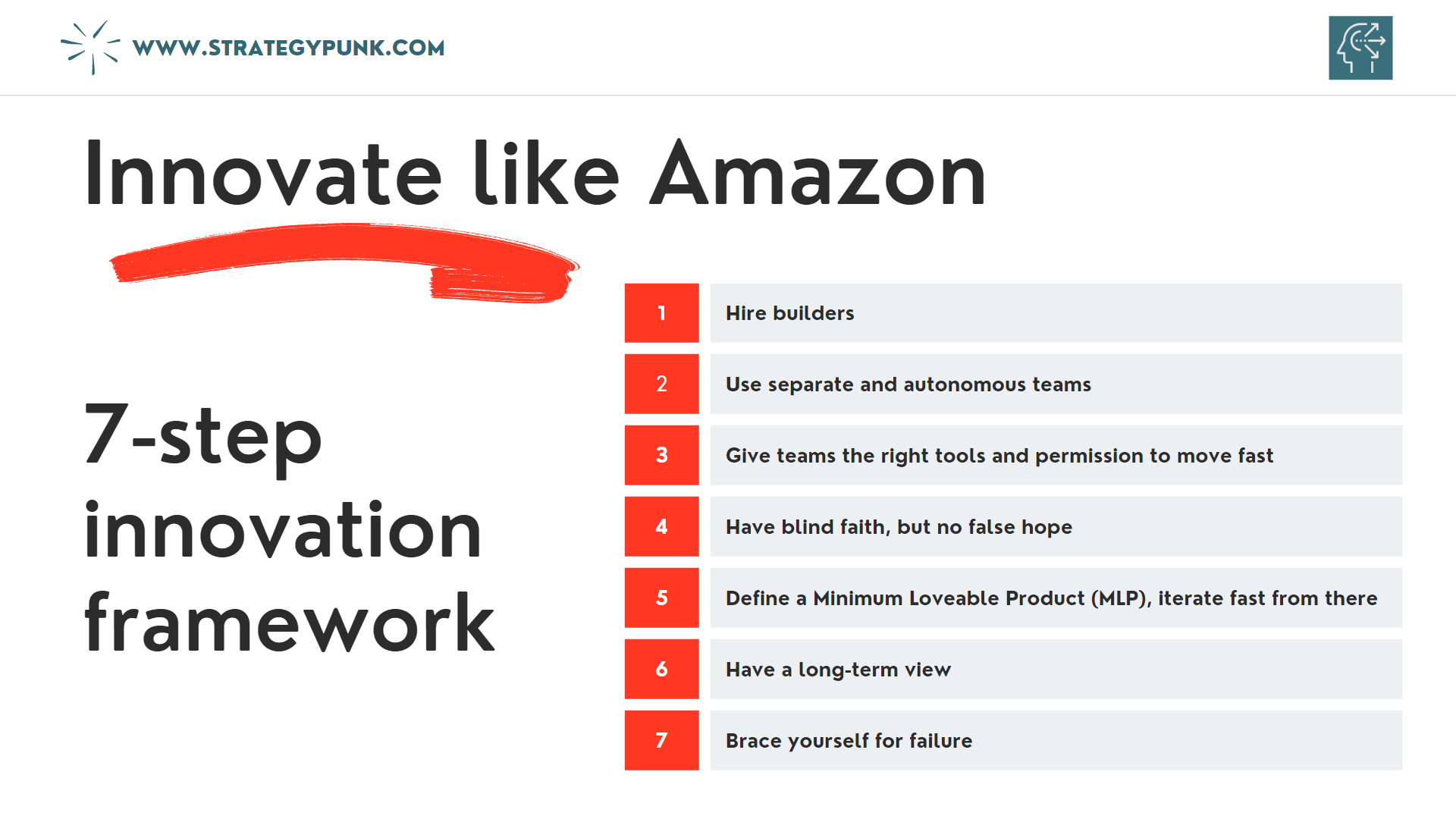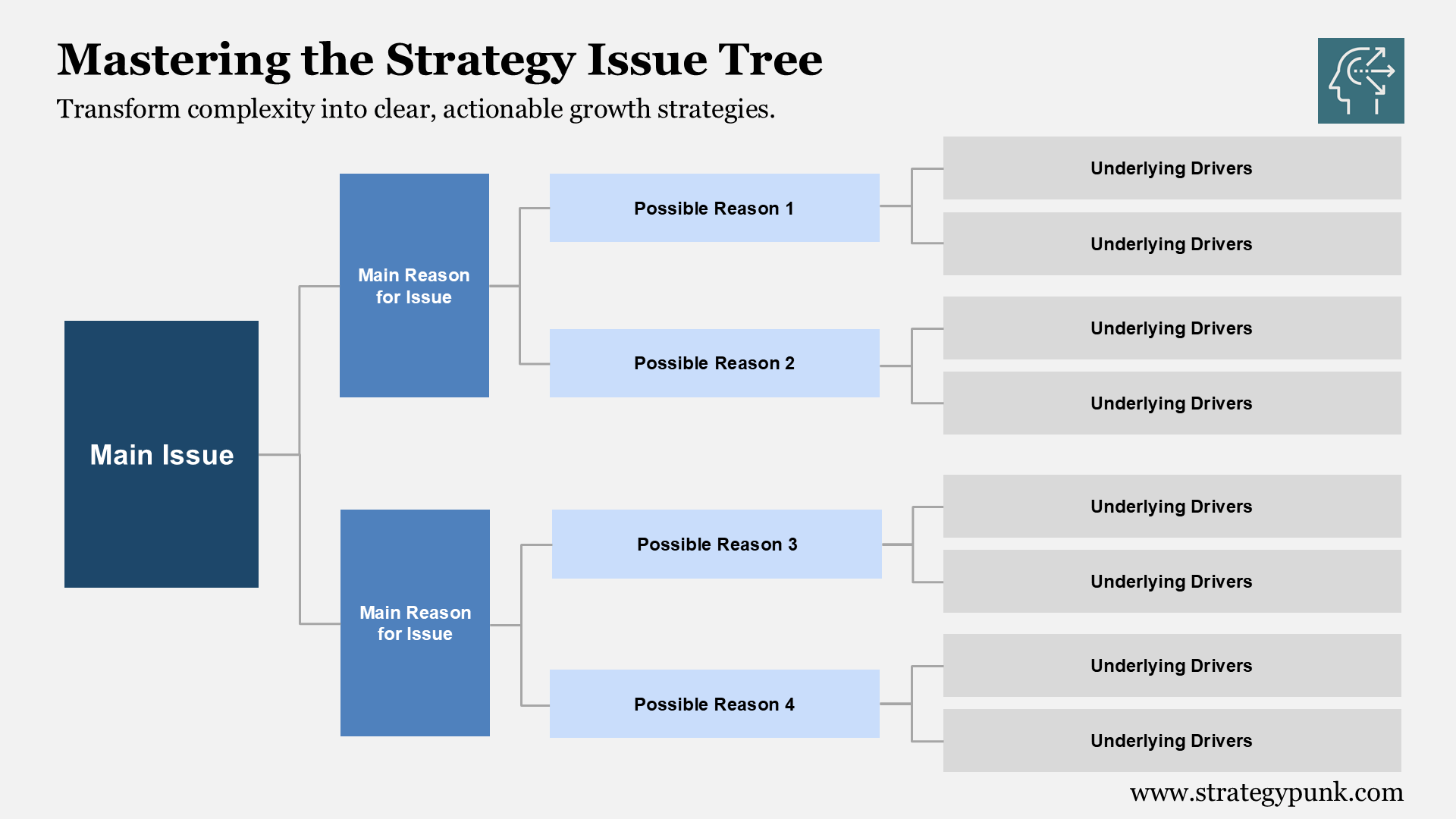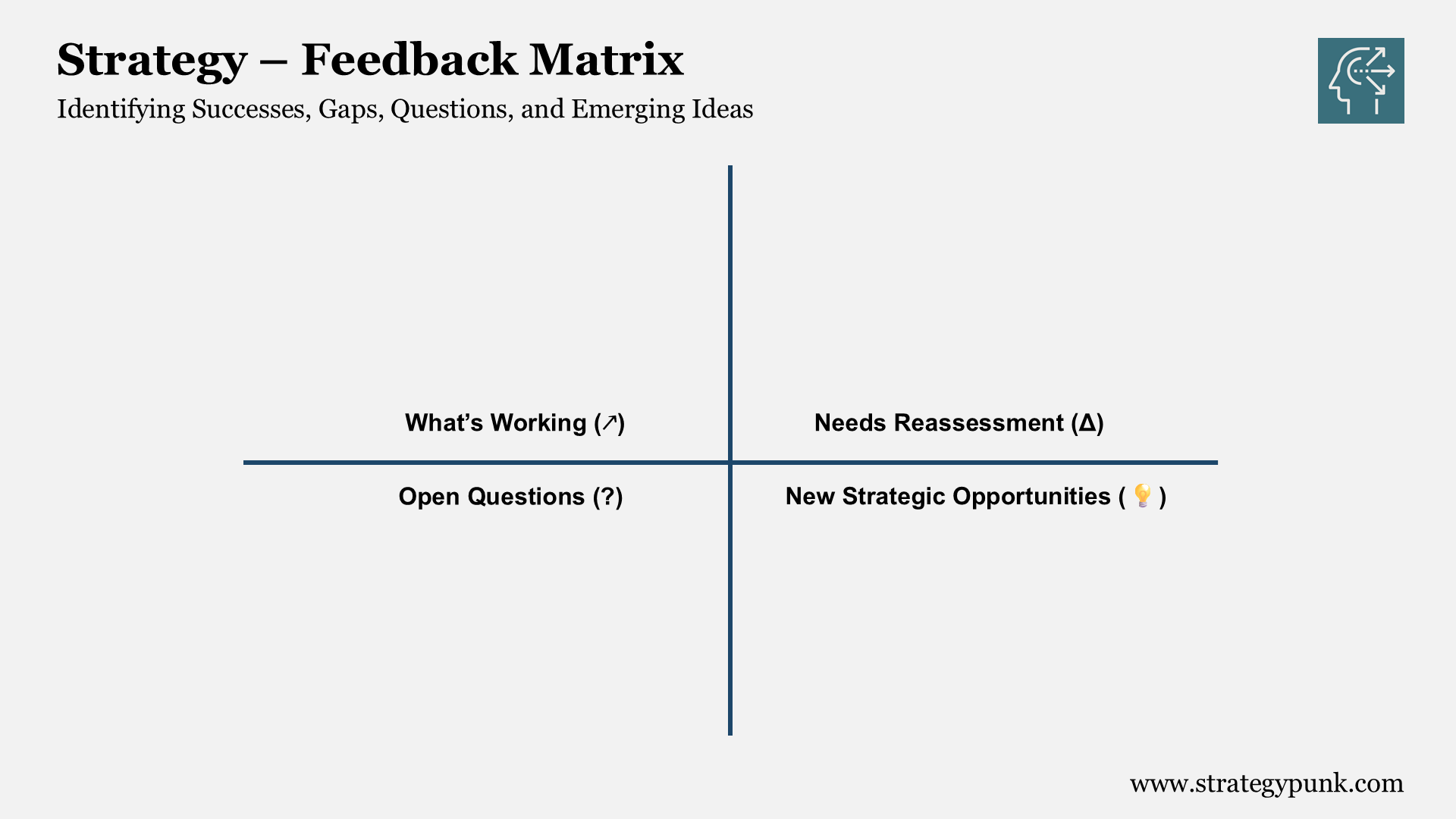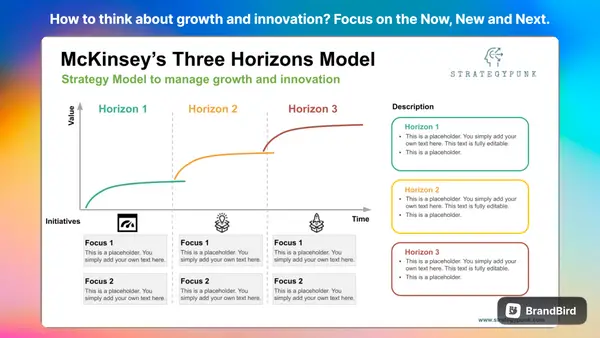Amazon SWOT Analysis: Free PPT Template and In-Depth Insights 2024
Free download: 2024 Amazon SWOT Analysis PowerPoint template. Quick, insightful analysis of Amazon's market position and strategic opportunities.

In the rapidly evolving fitness industry, marketers, strategists, and business analysts must understand a leading company like Amazon's strengths, weaknesses, opportunities, and threats (SWOT).
Amazon is a global e-commerce and technology giant that has revolutionized how we shop and consume digital content. Founded in 1994 by Jeff Bezos, the company has grown from an online bookstore to a multi-billion dollar empire spanning various industries.
In this article, we will conduct an in-depth SWOT Analysis of Amazon, exploring its strengths, weaknesses, opportunities, and threats. We will also provide a comprehensive overview of its strategies for success in 2024.
Our designed PowerPoint template offers an unparalleled deep dive into the core aspects that shape Amazon's market position.
Introduction to Amazon
Amazon is a multinational technology company based in Seattle, Washington. It started as an online bookstore and has since expanded into many products and services, including e-commerce, cloud computing, digital streaming, and artificial intelligence.
Amazon's mission is to be
We are the "Earth's most customer-centric company, where customers can find and discover anything they want to buy online."
A Brief Look at the History of Amazon
Amazon was founded by Jeff Bezos in 1994, initially operating out of his garage in Bellevue, Washington.
The company's first product was books, and it quickly gained popularity due to its wide selection and competitive prices. Over the years, Amazon expanded its product offerings to include various categories such as electronics, clothing, and household items.
In 2002, Amazon launched its web services division, now known as Amazon Web Services (AWS), which provides cloud computing services to businesses and individuals. This move proved a game-changer for the company, as AWS has become a significant revenue stream and a leader in the cloud computing market.
What is the business model of Amazon?
Amazon's business model is multifaceted, with several revenue streams contributing to its success. The primary sources of revenue include:3
- E-commerce: Amazon's core business is its online retail platform, where customers can purchase various products from third-party sellers and Amazon itself.
- Amazon Prime: This subscription service offers free shipping, streaming services, and other benefits for an annual fee.
- Amazon Web Services (AWS): AWS provides cloud computing services to businesses and individuals, including storage, computing power, and databases.
- Advertising: Amazon generates revenue through sponsored product listings and display advertising on its platform.
Financials of Amazon 2023
In 2023, Amazon reported impressive financial results, solidifying its position as a dominant force in the e-commerce and technology industries. According to the company's fourth-quarter earnings report:4
- Net sales increased by 12% to $574.8 billion in 2023, compared to $514.0 billion in 2022.
- Operating income increased to $24.1 billion in 2023, compared to $19.2 billion in 2022.
- Net income rose to $33.4 billion in 2023, compared to $27.7 billion in 2022.
These strong financial results demonstrate Amazon's ability to capitalize on the growing demand for e-commerce and cloud computing services and its commitment to operational excellence and customer satisfaction.
In-depth SWOT Analysis of Amazon 2024
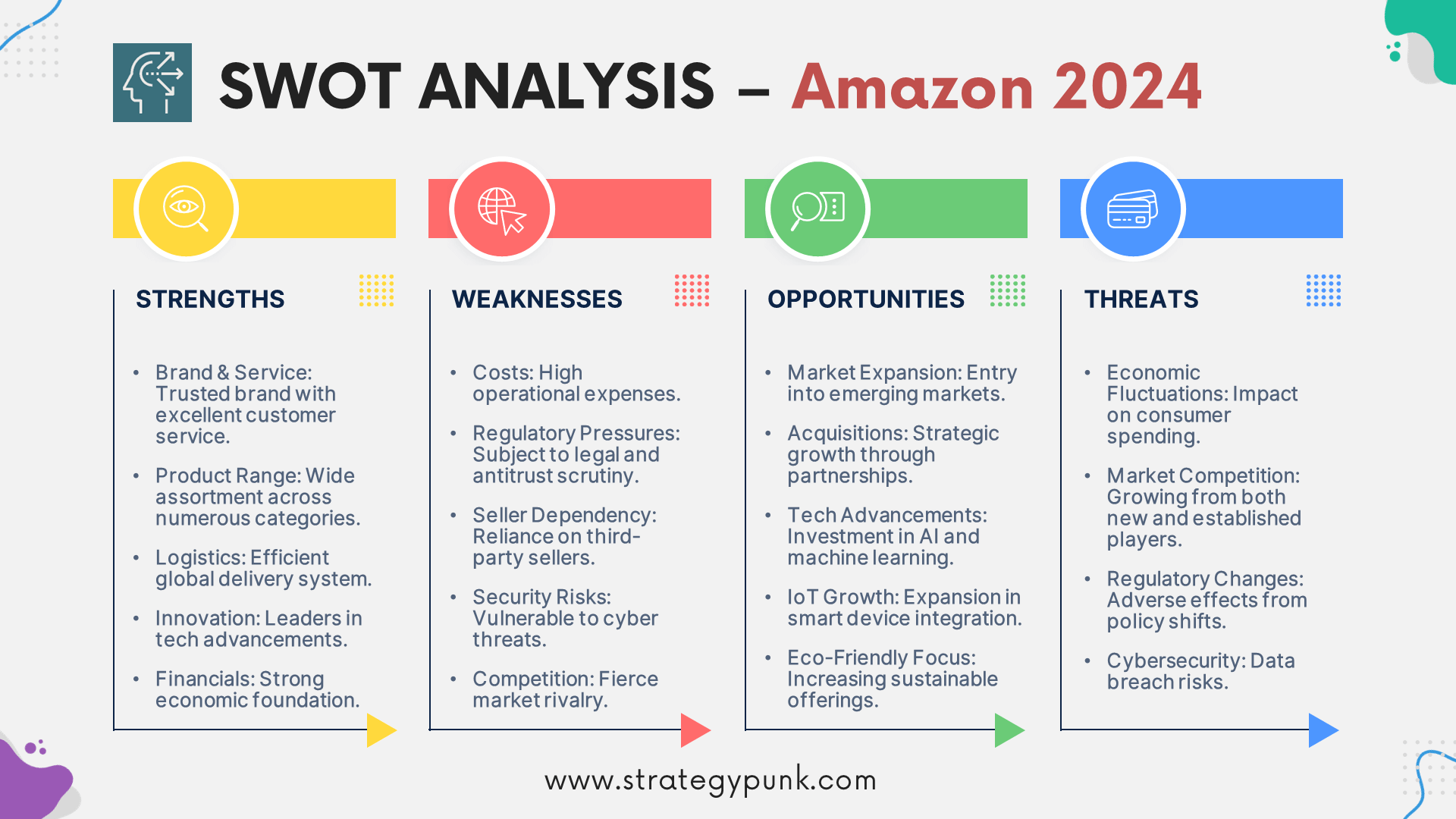
Strengths
- Strong brand recognition and reputation: Amazon has established itself as a trusted and reliable brand in consumers' eyes through its customer-centric approach, which focuses on providing excellent customer service and a wide range of convenient delivery options.
- Diverse product offerings: Amazon offers various products, such as clothing, books, electronics, and household goods, which has helped the company capture a significant share of the e-commerce market and remain competitive.
- Robust logistics and fulfillment network: Amazon has invested heavily in its logistics and fulfillment infrastructure, enabling it to provide fast and efficient delivery services to customers worldwide.
- Technological innovation: Amazon is known for its commitment to innovation. Amazon constantly develops new technologies and services, such as Amazon Prime, Alexa, and Amazon Go, to enhance the customer experience.
- Strong financial position4: Amazon's strong financial performance and cash reserves provide the company with the resources to invest in new initiatives, acquire companies, and expand its operations globally.
Weaknesses
- High operational costs: Amazon's extensive logistics and fulfillment network, as well as its investments in new technologies and initiatives, contribute to high operational costs, which can impact profitability.
- Regulatory scrutiny and legal challenges: Amazon faces increasing regulatory scrutiny and legal challenges related to antitrust concerns, labor practices, and data privacy issues, potentially impacting its operations and growth strategies.
- Dependence on third-party sellers: A significant portion of Amazon's revenue comes from third-party sellers, making maintaining consistent product quality and customer experience challenging.
- Cybersecurity risks: As a large e-commerce platform handling sensitive customer data, Amazon is vulnerable to potential cybersecurity threats and data breaches, which could damage its reputation and incur significant costs.
- Intense competition: Amazon faces intense competition from other e-commerce giants, such as Walmart and Alibaba, as well as traditional brick-and-mortar retailers that have expanded their online presence.
Opportunities
- Expansion into new markets: Amazon has the opportunity to expand its e-commerce and cloud computing services into emerging markets, particularly in developing countries with growing internet and smartphone penetration.
- Acquisitions and strategic partnerships: Amazon can leverage its financial strength to acquire companies, form partnerships that complement its existing business lines, or provide access to new technologies and markets.
- Artificial intelligence and machine learning: Amazon can further invest in artificial intelligence and machine learning technologies to enhance its product recommendations, supply chain optimization, and customer service capabilities.
- Internet of Things (IoT) and smart home devices: The growing demand for IoT and smart home devices presents an opportunity for Amazon to expand its product offerings and integrate its services, such as Alexa and Amazon Echo.
- Sustainable and eco-friendly initiatives: As consumers become more environmentally conscious, Amazon can capitalize on this trend by implementing sustainable practices and offering eco-friendly products and services.
Threats
- Economic downturns and consumer spending: Economic recessions or downturns can significantly impact consumer spending, decreasing Amazon's sales and profitability.
- Increasing competition: The e-commerce and cloud computing markets are becoming increasingly competitive, with new players and existing competitors investing in new technologies and services.
- Regulatory changes and trade policies: Changes in regulations, trade policies, and tax laws in the countries where Amazon operates could impact its business operations and profitability.
- Cybersecurity threats and data breaches: Amazon handles vast amounts of customer data, Making it vulnerable to potential cybersecurity threats and data breaches, which could damage its reputation and incur significant costs.
- Natural disasters and supply chain disruptions: Natural disasters, such as hurricanes or earthquakes, can disrupt Amazon's supply chain and logistics operations, leading to delivery delays and customer dissatisfaction.
Amazon SWOT Analysis Summary
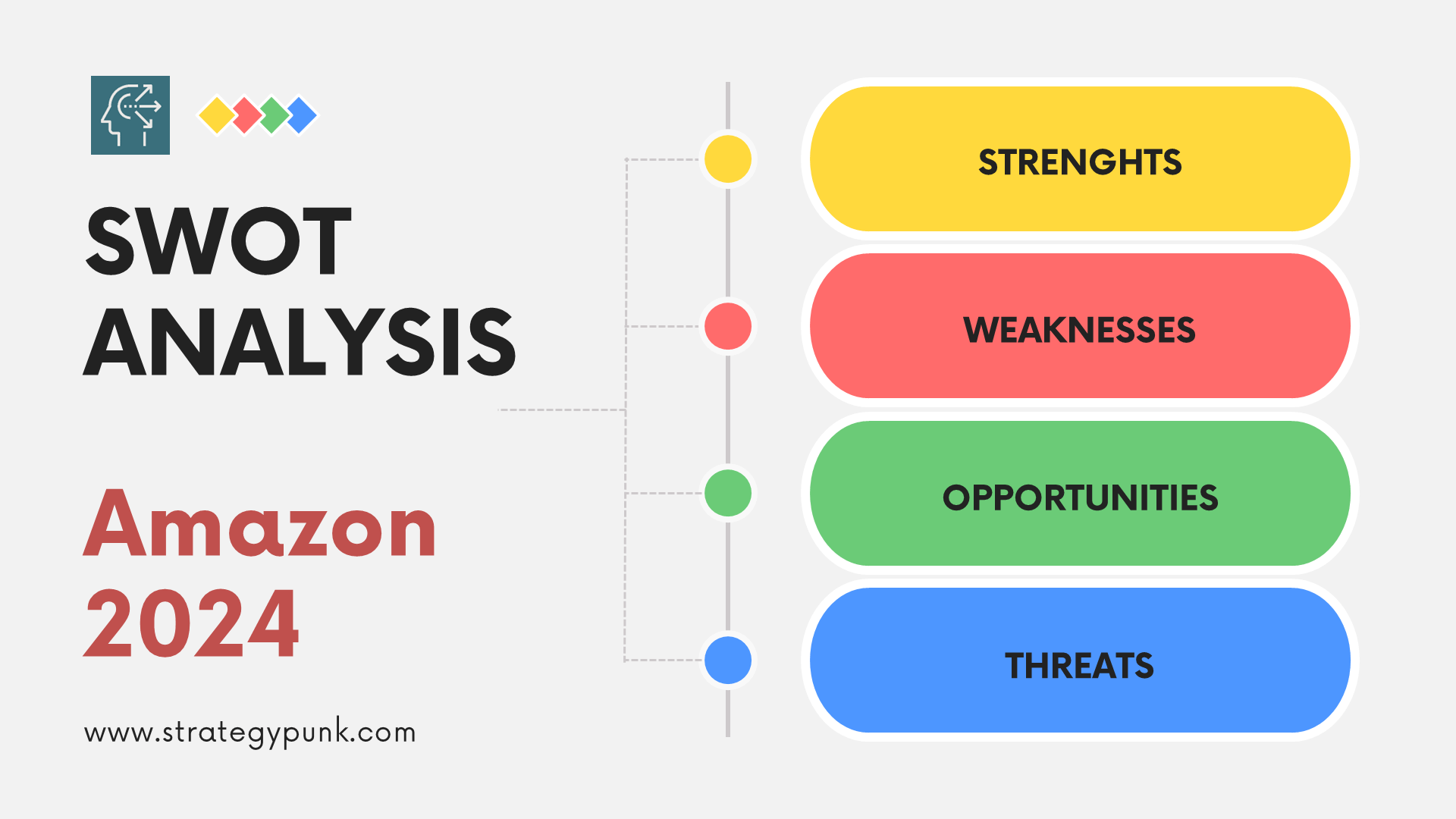
Internal Factors
Strengths:
- Strong brand recognition and reputation
- Diverse product offerings
- Robust logistics and fulfillment network
- Technological innovation
- Strong financial position
Weaknesses:
- High operational costs
- Regulatory scrutiny and legal challenges
- Dependence on third-party sellers
- Cybersecurity risks
- Intense competition
External Factors
Opportunities:
- Expansion into new markets
- Acquisitions and strategic partnerships
- Artificial intelligence and machine learning
- Internet of Things (IoT) and smart home devices
- Sustainable and eco-friendly initiatives
Threats:
- Economic downturns and consumer spending
- Increasing competition
- Regulatory changes and trade policies
- Cybersecurity threats and data breaches
- Natural disasters and supply chain disruptions
Amazon's strategies for success
To capitalize on its strengths, address its weaknesses, seize opportunities, and mitigate threats, Amazon should consider the following strategies:
- Continued investment in innovation: Amazon should continue to invest in emerging technologies, such as artificial intelligence, machine learning, and IoT, to enhance its products and services and stay ahead of the competition.
- Expansion into new markets: Amazon should explore opportunities to expand its e-commerce and cloud computing services into emerging markets, particularly in developing countries with growing internet and smartphone penetration.
- Strategic acquisitions and partnerships: Amazon should leverage its financial strength to acquire companies or form partnerships that complement its existing business lines or provide access to new technologies and markets.
- Emphasis on sustainability and eco-friendly initiatives: As consumers become more environmentally conscious, Amazon should implement sustainable practices and offer eco-friendly products and services to cater to this growing demand.
- Strengthening cybersecurity measures: Amazon should invest in robust cybersecurity measures and implement strict data privacy policies to address cybersecurity risks and maintain customer trust.
- Regulatory compliance and transparency: Amazon should proactively address regulatory concerns and legal challenges by ensuring compliance with relevant laws and regulations and maintaining transparency in its business practices.
- Enhancing customer experience: Amazon should prioritize customer satisfaction by improving its logistics and fulfillment network, providing excellent customer service, and offering a wide range of high-quality products and services.
Frequently Asked Questions
What is Amazon's primary business model?
Amazon's primary business model is e-commerce, which operates an online retail platform for customers to purchase a wide range of products from third-party sellers and Amazon itself. However, the company also generates significant revenue from other sources, such as Amazon Prime subscriptions, Amazon Web Services (AWS), and advertising.
What are Amazon's significant strengths?
Amazon's major strengths include its strong brand recognition and reputation, diverse product offerings, robust logistics and fulfillment network, technological innovation, and strong financial position.
What are some of Amazon's weaknesses?
Some of Amazon's weaknesses include high operational costs, regulatory scrutiny and legal challenges, dependence on third-party sellers, cybersecurity risks, and intense competition.
What opportunities does Amazon have for future growth?
Amazon can expand into new markets, particularly in developing countries, pursue strategic acquisitions and partnerships, invest in emerging technologies like artificial intelligence and machine learning, and significant sustainable and eco-friendly initiatives.
What are the major threats facing Amazon?
Amazon's significant threats include economic downturns and fluctuations in consumer spending, increasing competition in the e-commerce and cloud computing markets, regulatory changes and trade policies, cybersecurity threats and data breaches, and natural disasters and supply chain disruptions.
What are Amazon's key strengths that have enabled its success?
Some of Amazon's core strengths include its strong brand recognition, vast product selection, excellent logistics and distribution network, leadership in cloud computing through AWS, innovation culture, and obsessive customer-centricity.
How does Amazon identify and evaluate potential acquisition targets?
Amazon looks for acquisition opportunities that can expand its capabilities, provide access to new markets or technologies, and create synergies. It employs a rigorous process to assess strategic fit, potential risks, and value creation before pursuing M&A deals.3
What role does Amazon's cloud computing platform AWS play in its overall strategy?
AWS is a key pillar of Amazon's strategy and growth. It provides a highly profitable revenue stream, enables Amazon to build and scale its services cost-effectively, and opens doors to enterprise customers. AWS also supports Amazon's M&A strategy.3
How does Amazon's "Working Backwards" product development process work?
Amazon uses a customer-centric product development approach called "Working Backwards". It starts by writing a mock press release (PR) and FAQ to define the customer experience and work backward to the product requirements. This helps align the team and get stakeholder buy-in early.
What are some of Amazon's most immense opportunities for future growth?
Opportunities for Amazon include further international expansion in emerging markets, opening more physical stores to complement its online presence, leveraging its logistics network to offer shipping services, and innovating in areas like healthcare, financial services, and autonomous vehicles.
How do Amazon's leadership principles guide decision-making and company culture?
Amazon's 16 leadership principles act as a decision-making framework and define its culture. They include customer obsession, ownership, a bias for action, frugality, earning trust, and delivering results. Employees are evaluated based on these principles.
How does Amazon decide whether to build vs buy when entering new markets or product categories?
Amazon takes a pragmatic approach to developing in-house capabilities with a unique value proposition or cost advantage while pursuing acquisitions to quickly gain talent, technology, or market access when speed is critical. Make vs buy decisions are made case-by-case.3
What is unique about Amazon's approach to mergers and acquisitions?
Amazon's M&A strategy focuses on deals accelerating its roadmap in strategic areas like retail, media, and technology. It has a disciplined valuation approach, emphasizes cultural fit, and aims to preserve the autonomy of acquired companies while providing resources to scale.3
Amazon SWOT Analysis PowerPoint Template
free and fully editable PPT template
A SWOT analysis evaluates the strengths, weaknesses, opportunities, and threats impacting a company.
A free PowerPoint presentation template summarizing this Amazon SWOT analysis is available for download.
The presentation visually captures Amazon's internal strengths and weaknesses, external opportunities and threats. It can be used for strategic planning sessions or business presentations.
Amazon SWOT Analysis PowerPoint Template
Amazon SWOT Analysis PDF Template
Discover more
Clickworthy Resources
SWOT Analysis: Free PowerPoint Template
This PowerPoint slide deck contains five different layouts to complete a SWOT analysis.
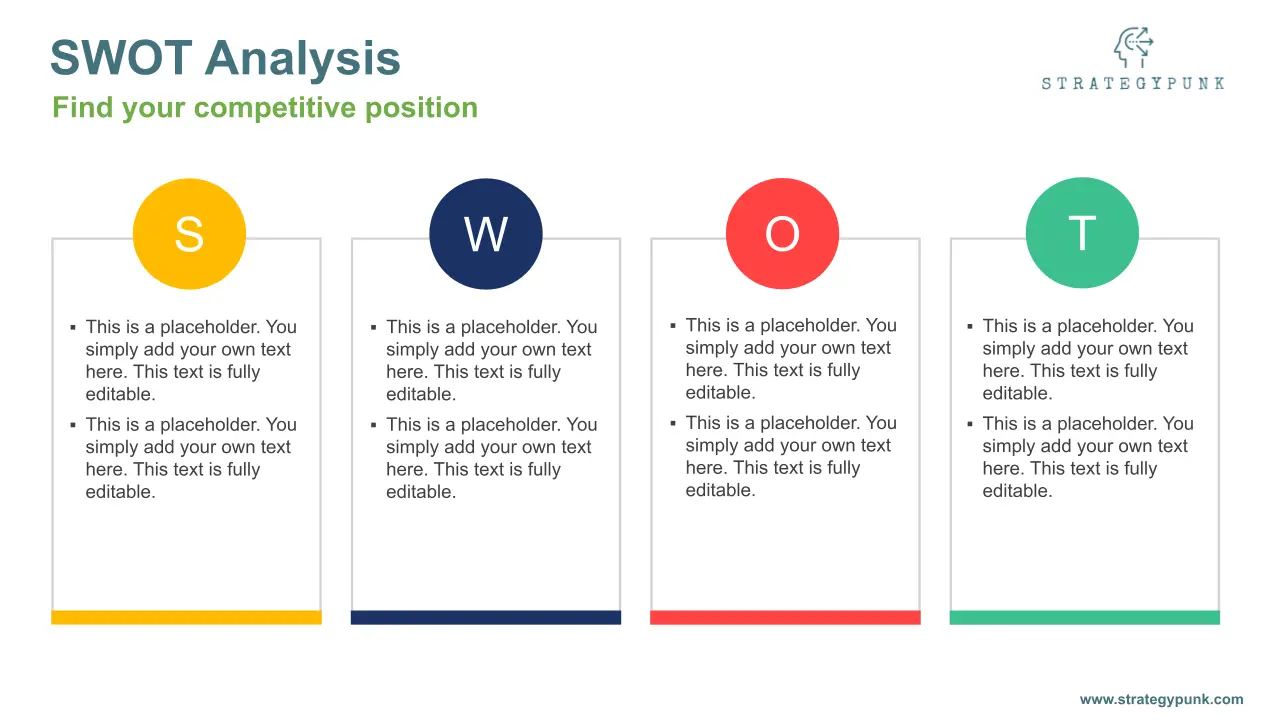
New! SWOT Framework & Free PPT Template - 2024 Edition
Dive into the 2024 Edition of our SWOT Analysis guide, complete with a free PowerPoint template. This resource covers the essentials of conducting a SWOT analysis, its benefits, and practical application tips, including a case study on Mercedes Benz.

Innovate like Amazon: The 7-step innovation framework
Innovate like Amazon: The 7-step innovation framework by Andy Jassy. Free and fully editable framework template.
